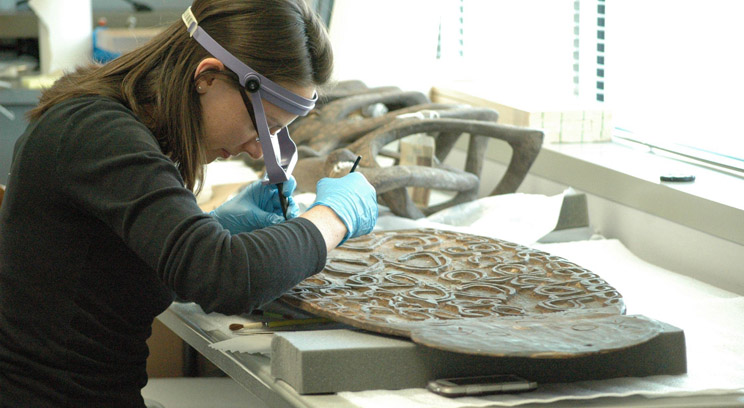Connections between the sculpture and oral traditions of the Asmat people – inhabitants of a low-lying rainforest region of Papua, Indonesia – will be explored in the American Museum of Asmat Art’s new exhibition, “Wowipitsj: Man, Myth, Legend,” which will run Feb. 4 to Aug. 4 at the University of St. Thomas.
The Asmat are well-known for their sculpture. The challenges of reaching this remote part of southwestern Papua meant Asmat communities had little contact with the outside world until the 1950s. Outsiders have immigrated into the Asmat region for several decades, bringing their cultural beliefs and practices along with them.
Some aspects of Asmat culture have changed dramatically with the introduction of new cultural beliefs as well as imported technology and other mass-produced goods; however, two traditional Asmat art forms that are the focus of the St. Thomas exhibition – carving and storytelling – remain vibrant.
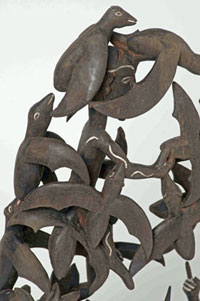
This Asmat carving by Antonius Kamem depicts a man being transported by bats to the ancestral world of Safan. Kamem is from is from the village of Atsj in the Becembub region of Asmat.
The exhibition features carvings by Asmat master carvers, known as the wowipitsj. The works on display were chosen from more than 2,000 carvings and artifacts in the American Museum of Asmat Art collection, one of the most comprehensive of its kind in the United States.
The St. Thomas exhibition was curated by art history graduate student Rachel Simmons. A board member of the Scott County Historical Society, where she has served as a curatorial intern, Simmons worked as a graduate assistant for the American Museum of Asmat Art for two years and knows the collection well.
“Carving remains a fundamental part of Asmat culture,” Simmons said. “The exhibit explains how their art connects with critical concepts in their culture.”
Dr. Julie Risser, director of the American Museum of Asmat Art, said Asmat culture holds a deep respect for ancestors; Asmat people believe that ancestor spirits embody the world around them and that sacred objects can become a home to these powerful forces.
She explained that this core concept is reflected in both carving and oral traditions. According to one Asmat tradition, a man named Fumeripits found himself alone after experiencing a harrowing journey. To end his loneliness, he carved human figures from wood. The figures lay lifeless around him; however, when he carved a drum and beat out a rhythm on it, spirit entered the forms and the carvings began to move. At first the figures’ movements were jerky but later became graceful.
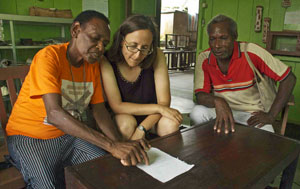
Beata Atakat, left, a recognized Asmat fiber artist, discusses a weaving project with Dr. Julie Risser, director of the American Museum of Asmat Art. Atakat is from the Asmat village of Atsj.
“An Asmat community could have many carvers,” Risser said, “but the wowipitsj are the masters and the most-respected. For example, if a village is carving a wuramon or “spirit canoe,” each family might have a carver who would create one of the many figures in the canoe; however, the wowipitsj would oversee and guide the project.
“The processes by which large-scale sacred carvings are created and the contexts in which they are used remain a central part of Asmat animistic faith; they strengthen relationships with ancestral spirits,” she said. “Today, many wowipitsj have expanded their carving repertoire and make narrative carvings for an external clientele. This exhibition features those narrative carvings that are inspired by oral traditions.”
The carvings clearly reflect life in the Asmat’s rainforest environment. An estimated 70,000 Asmat live in several hundred villages that are located in tidal and freshwater swamps and lowland rainforest.
The late Michael Rockefeller, who died in 1961 while on an art-collecting expedition, described the Asmat region as “essentially a gigantic mud plain. … Mud is everywhere; even the rivers are gray with it.” Because of frequent flooding, many dwellings are built on posts several feet off the ground or, in some case, in trees. There are few roads but raised boardwalks are common throughout the region.

This carving by Anton Dapo depicts people and animals seeking refuge from a flood by climbing a beringen tree. The artist is from the village of Simsagar in the Safan region of Asmat. St. Thomas photo by Mark Jensen.
Curator Simmons said one of her favorite pieces in the exhibit is a carving by Anton Dapo from the village of Simsagar; created from a single piece of wood, it depicts people and animals climbing a beringen tree to escape a flood.
Risser noted that climate change is of particular concern in the Asmat region because so much of the land is flood-prone swamp. She and other museum staff are looking forward to a planned visit to the “Wowipitsj: Man, Myth, Legend” exhibition on Feb. 20 by internationally known science and climate-change expert Bill McKibben.
He will be at St. Thomas and Macalester College Feb. 20 and 21 for an event titled “In Celebration and Preservation of Winter: Responding to Climate Change in Minnesota and Wisconsin.” Founder of an organization called 350.org, McKibben was called by the Boston Globe “probably the country’s most important environmentalist” and by Time magazine as “the planet’s best green journalist.”
The American Crosier Fathers and Brothers began collecting Asmat art when they first arrived there in the 1950s.
An article on the Crosier website notes that during the order’s early years in Asmat, the Second Vatican Council produced three critical documents: The Church, The Church in the World and the Missionary Church, “which provided inspiration and direction to the Crosier missionaries. These include holding the people’s language and way of life in great esteem, the building of communities of faith endowed with the cultural riches of the people and borrowing from the customs, traditions, wisdom, teaching, arts and sciences of the people.”
“These documents encouraged us to have a holistic approach to the mission,” Crosier Father Ed Greiwe said in the article. “This included a respect for their traditional beliefs, their culture and customs, concern about the education of the people, about their health, about their own local leadership and economic well-being and development.”
By 1973, the Crosiers had collected and preserved more than 1,400 examples of Asmat carvings and artifacts, a challenge in a jungle climate where heat and humidity can destroy wooden and fibrous objects.
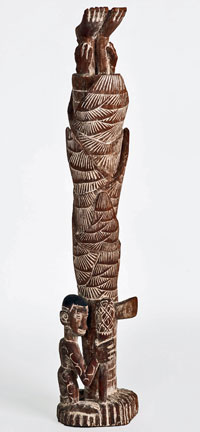
Carving of a figure in in a sago tree by Maximus Otor. He lives in the village of Warse in the Simai region of Asmat.
The collection – including finely crocheted masks, stunningly carved shields, long and narrow “spirit canoes” and tall ancestor or bisj poles – was first displayed in the Asmat city of Agats from 1973 to 1975, when it was moved to the Crosier Asmat Museum in Nebraska. The collection moved again in 1995 to the newly established American Museum of Asmat Art in Shoreview where it remained until 2007 when it was donated to St. Thomas by the American Crosier Fathers and Brothers and the Diocese of Agats.
Since then, museum director Risser and the museum’s Acquisitions Committee expanded the collection by more than 500 pieces. Risser purchased some of the works directly from artists during three trips to Asmat.
Many more came from Bishop Alphonse Sowada, a Crossier from the United States who first arrived in Asmat in 1961 and became the first bishop of the Diocese of Agats in 1969. Like many members of the Crossier order who served in Asmat, Sowada held a degree in anthropology and encouraged the Asmat people to preserve their culture through art and the preservation of rituals and feasts.
Two others who added to the collection were Minnesotans Donna and the late Cargill MacMillan Jr.; they traveled to Asmat at least twice where they purchased items at the annual fall “Pesta Budaya Asmat” (Asmat Art Festival).
For the wowipitsj exhibit, curator Simmons selected works from the Crosiers’ original collection as well as newer pieces collected by Risser, Sowada and the MacMillans.
In addition to the museum at St. Thomas, large collections of Asmat art and artifacts can be found at the Metropolitan Museum of Art in New York City and the Tropenmuseum in Amsterdam. In 2009, the Minneapolis Institute of Arts displayed 72 pieces from the St. Thomas collection during a four-month exhibition. Some art historians believe that Asmat art influenced modernist and surrealist Western artists such as Henri Matisse, Marc Chagall and Pablo Picasso.
“Wowipitsj: Man, Myth, Legend” marks the American Museum of Asmat Art’s third exhibition in the Anderson Student Center’s Gallery since the student center opened in January 2012.
The exhibition, free and open to the public, can be seen Feb. 4 to Aug. 4. The Gallery is located on the second floor of the student center at Summit and Cretin avenues.
Exhibition hours are from 10 a.m. to 4 p.m. Mondays through Wednesdays, from 10 a.m. to 8 p.m. Thursdays, from 10 a.m. to 2 p.m. Fridays, and from noon to 4 p.m. on weekends. More information is available at (651) 962-5512 and the museum’s website.
The American Museum of Asmat Art will host an exhibition reception at 6 p.m. Thursday, March 14, in The Gallery.
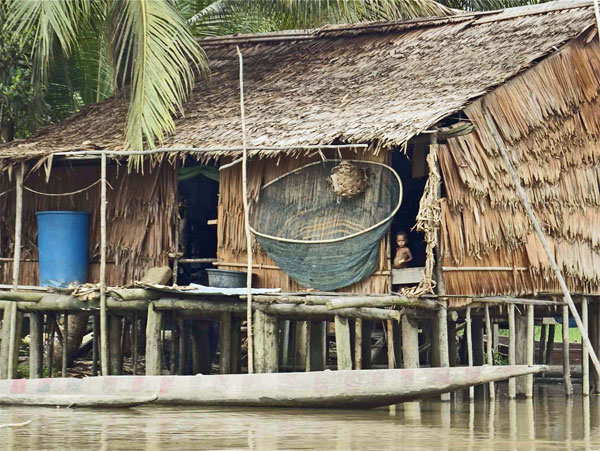
The Asmat area is prone to flooding. The solution: Build your home on poles. This 2009 photo was taken in Sawa, Papua, Indonesia, by Dr. Julie Risser during one of her three trips there.
